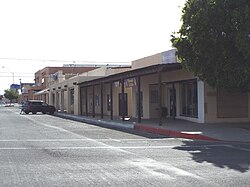- The Old Parker Jail viewed from a different angle
- The Old Presbyterian Church a.k.a. Mojave Indian Presbyterian Mission Church
- The Old Presbyterian Church as viewed from a different angle
- The Old Presbyterian Church School
- Old Parker High School
- The Arizona and California Railroad Bridge a.k.a. “The Colorado River Bridge”
- The Trestle of the Arizona and California Railroad Bridge
- The Arizona and California Railroad Station
- The Arizona and California Railroad Station viewed from a different angle
- The Arizona and California Railroad Station Storage-Depot
- Town of Parker railroad car
- The Parker Dam as viewed from Arizona
- The Parker Dam as viewed from California
List of historic properties in Parker, Arizona | |
|---|---|
 Downtown historic Parker | |
 Location of Parker in La Paz County, Arizona. |
| Part of a series of the |
| Cities, towns and CDPs in Arizona with lists and images of historic properties, forts, cemeteries or historic districts |
|---|
This is a list, which includes a photographic gallery, of some of the remaining structures and monuments, of historic significance in Parker, a town in La Paz County, Arizona. Parker is the county seat of La Paz County, Arizona, United States, [1] on the Colorado River in Parker Valley.














